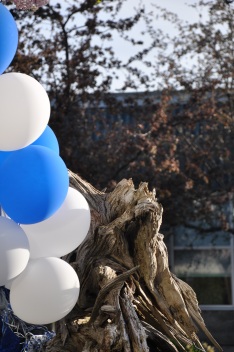My experience with exercise 1:
For this exercise we had to choose a particular scene or spot and take 60 pictures every minute, keeping in mind light change. Therefore my colleague and I were searching for a spot where we could notice the sun going down. We shot the pictures at around 7pm. We wanted to feature something that would constantly move in order to see the continuity and movement when creating the short movie later on. We found some balloons and put them right next to a cut trunk to contrast the smooth surface of the balloons with the rather textured trunk. We made sure that the sun was hitting on them at first so we could tell the difference after shooting the different images. However, while we were taking the pictures, I noticed that the timing wasn’t really perfect because the sun light looked like it was as bright however it was going down. For instance the two images above were taken at two different timings, yet they look like they were taken only a few minutes later. Something that could help tell which one was taken at sunset is the orange color reflected on the white balloon. I was quite observant of the surroundings because I wanted to make sure that the sun light would make a difference in the images that were captured. The light change is noticeable however I was hoping that the contrast was stronger.
As we were taking the pictures, I noticed that the sun light was also hitting on the trunk and the leaves of the tree in the background, which helped tell when the sun was brighter. Also, before taking the pictures we thought of including a sort of shadow to see it move as the sun went down but we couldn’t really capture it because we took a close up of the balloons rather than a landscape of the whole scene. We chose to take a close up in order to focus on one thing only and not have other distractions in the frame.
Back in the studio, I noticed something in the pictures. Other than the fact that the light change wasn’t that obvious, the composition in some of the pictures seemed like it was slightly different than the other images. While taking pictures, we made sure that the camera stayed in one position without moving at all, therefore we got a chair to place it on. I found it surprising that we had slight changes in the composition afterwards. I think a tripod or a totally flat surface would’ve made it easier. Also, some of the pictures were sort of blurry because the camera focused on the background rather than focusing on the balloons.
After assembling the images, the balloons looked like they were actually moving which I found interesting. The smaller the frame number was, the faster the pictures were scrolling. At first when we assembled the images, the video came to a final one minute clip which looked quite slow. Then we had to bring it up to 30 seconds which made the pictures scroll faster and look more like they were linked. I think it is important to know what proper frame number to use in order to have a decent sequence of images that could look like they’re in motion. The light helps determine this sequence too.
I found this exercise quite interesting because I had never used Premiere Pro before. Also I learnt how light and duration could affect a time-based video. If I were to repeat this exercise I would make sure I pick a later time so I can show the transition from brightness to darkness.


